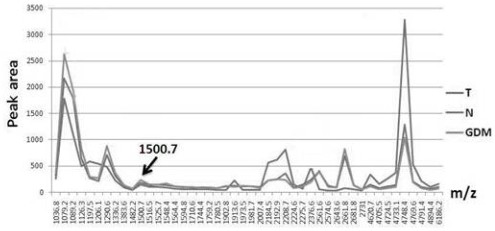Application of urine IGKC protein and polypeptide fragment thereof in normal pregnancy or gestational diabetes
A technology of gestational diabetes and polypeptide fragments, applied in immunoglobulins, anti-animal/human immunoglobulins, peptides, etc., can solve the problems of frequent monitoring and achieve the effect of convenient storage
- Summary
- Abstract
- Description
- Claims
- Application Information
AI Technical Summary
Problems solved by technology
Method used
Image
Examples
Embodiment 1
[0024] Example 1 Urine Specimen Collection and Processing
[0025] A total of 60 patients with gestational diabetes mellitus (GDM) were clinically diagnosed in the Obstetrics Department of Beijing Shijitan Hospital Affiliated to Capital Medical University, including 30 samples from the second trimester (GDM-M, 13-27 weekends) and 30 samples from the third trimester (GDM-M). L, 28 weeks and later) samples; 31 cases of normal pregnant women (N) with routine outpatient check-ups; 31 cases of healthy middle-aged urine samples from normal pregnant women (T), the control group, all aged 15 to 10 years old 49 years old. After the urine was collected, it was centrifuged at 400×g for 5 minutes, the supernatant was taken, aliquoted, and frozen at -80°C. Inclusion criteria: Patients with gestational diabetes mellitus and normal pregnant women have their first pregnancy examination and file in our hospital since the early pregnancy (8-12 weeks), and the data are complete; A 75-g o...
Embodiment 2
[0029] Example 2 Magnetic bead purification and screening of urine peptides
[0030]Weak cation-exchange magnetic beads were used to enrich the peptides in urine, and matrix-assisted laser desorption ionization time-of-flight mass spectrometry (MALDI-TOF MS) was used to analyze the peptide spectrum in urine. After calibrating the instrument with a standard, mix 1 μl of the eluate with 10 μl of matrix (0.3 % α-cyano-4-hydroxycinnamic acid, HCCA), and take 1 μl to spot on the Anchorchip (Autoflex MALDITOF, Bruker-Dalton) target plate on, dry at room temperature. The sample is ionized by nitrogen laser irradiation and then subjected to mass spectrometry analysis, collecting data in the range of 1000-10000 Da, and obtaining a mass spectrogram composed of protein peaks with different mass-to-charge ratios. For each MALDI crystallization site, a total of 400 laser irradiations (50 irradiations at 8 different positions of each crystallization site), the average value represents a...
Embodiment 4
[0031] Example 4 Identification and Analysis of Differential Peptides
[0032] Take 20ul from the sample tube for LC-MS / MS analysis. EASY-nLC1000 HPLC system was used for separation. Liquid phase A was 0.1% formic acid in acetonitrile (2% acetonitrile), and liquid phase B was 0.1% formic acid in acetonitrile (98% acetonitrile). 100% solution A equilibrates a 100×100mm BEHnanoACquity column with a flow rate of 400nl / min. The chromatographic spray needle is PN: FS360-20-10-N-20-C12. Samples were separated by capillary high-performance liquid chromatography and analyzed by a Q-Exactive mass spectrometer (Thermo). The ion source voltage is 3.5kv, the analysis time is 120min, and the precursor ion scanning range is 300-2000m / z. Mass-to-charge ratios of peptides and peptide fragments were collected as follows: 20 fragments were collected after each full scan (MS2scan, HCD). At M / Z 200, MS1 has a resolution of 70,000 and MS2 has a resolution of 17,500. The data analysis soft...
PUM
 Login to View More
Login to View More Abstract
Description
Claims
Application Information
 Login to View More
Login to View More - R&D
- Intellectual Property
- Life Sciences
- Materials
- Tech Scout
- Unparalleled Data Quality
- Higher Quality Content
- 60% Fewer Hallucinations
Browse by: Latest US Patents, China's latest patents, Technical Efficacy Thesaurus, Application Domain, Technology Topic, Popular Technical Reports.
© 2025 PatSnap. All rights reserved.Legal|Privacy policy|Modern Slavery Act Transparency Statement|Sitemap|About US| Contact US: help@patsnap.com



